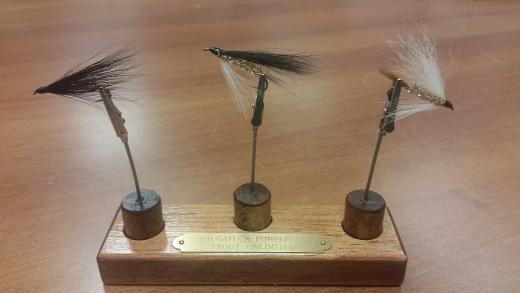TYING FLIES -- A QUIET, GENTLE SPORT
"The fly fisherman who knows nothing of his flies is as great an anachronism as the painter who knows nothing about his paints. More, he is a bad man in business." - J.W. Dunne.
The late J.W. Dunne was a well known British fly dresser who originated many May fly patterns and is the author of Sunshine and The Dry Fly. Izaak Walton and his book THE COMPLEAT ANGLER that was first published in 1653 is better known to anglers.
" More Directions how to fish for, and how to make for the Trout an Artificial Minnow and Flies, with some Merriment" is the the title of chapter V. Most fly fisherman own a copy of one of the many editions of the Compleat Angler, at least one fly publication, an Orvis and L.L. Bean catalog, a collection of magazine articles, and a fly fishing video. If you fly fish for any of the following species: trout, Atlantic salmon, Pacific salmon, steelhead, stripers, bluefish, false albacore, bonito, largemouth bass, smallmouth bass, crappie, sunfish and pike, then you probably have a good supply of flies and an extensive collection of research materials.
In the two centuries that anglers have been fly fishing, a few thousand fly tiers created thousands of fly patterns. There are at least 10,000 different trout flies that attempt to replicate approximately 300 insects in the entomology listings for the trout food chain. The listing of Atlantic salmon flies exceeds 1600 patterns. And, the relatively new sports of steelhead and Pacific salmon fishing has quickly accumulated a roster of around 700 different "ties," then there are patterns for catching bass, sunfish, pike and many marine species including bluefish, striped bass, Atlantic bonito and false albacore. The catalog of freshwater flies includes at least 16,000 different "dressed hooks." The litany of fly- types for each fish species of grows daily. If you are a fly rodder and don't tie, you are missing one of the most satisfying aspects of fly fishing--catching a fish on a fly that you have tied. All "dressed-hook fishers" love to see a trout grab a floating fly; that's why some "wand wafters" become dry-fly purists.
Dry flies are meant to represent flies that float on or in the surface. Dries used for trout range in sizes 10 to 28. Here are most of the types of dries: fan winged, all-hackle, coffin, parachute, caddis, poppers, hoppers, Wulffs, irrestibles, elk wing, thorax, humpy, ants, midges, and gnats. There are too many dry flies to even suggest a starting list. You determine which dry flies should be in your fly box by the rivers and seasons you fish, and the fly sizes that are best for them. A novice fly-rodder should defer fishing dry flies until he/she has learned the rudiments of the sport.
Then there are a variety of wet flies; flies that do not float on the water’s surface. The types include: nymphs, wets (winged and hackle only), woolybuggers, bucktails, streamers, terrestrials and weighted flies.
There are flies that are used primarily in freshwater streams and rivers, lakes and ponds and in all types of saltwater environments There are flies that are categorized by the species they are used to catch. They include: panfish, pike, black and calico bass, trout, striped bass, bluefish, bonito, false albacore,steelhead, Pacific salmon and Atlantic salmon. Novices can learn to fly fish more productively when using wet flies for any species or tiny, foam floating flies for panfish.
Some forms of fly fishing are a form of art; a gentle sport with beauty in the casting.
FLY TYING WORKSHOP — Winter is an opportune time to tie flies. Here’s one way to start.WEDNESDAYS, JAN. 25th, 6:45 pm - 9:00 pm. The FLY TYING WORKSHOPS take place the 2nd, 3rd & 4th (& sometimes 5th) Wednesday of each month from November thru the end of March at the Southbury Stop & Shop Community Room (2nd floor, elevator available), Southbury Plaza Shopping Center, 100 Main Street North, Southbury, CT (I-84 exit 15).
These workshops are FREE & open to the public. Stop by and learn how to tie flies. No experience is necessary. If you don't have tools and materials, you may use what is available at the workshop. Kids & families are welcome! Please join us any time ... & bring a friend!
OUTDOORS 1/20/17 Bob Gregorski

